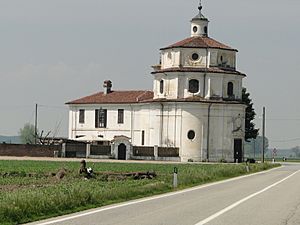Bernardo Antonio Vittone facts for kids
Bernardo Antonio Vittone (born August 19, 1704 – died October 19, 1770) was a famous Italian architect and writer. He was one of the three most important Baroque architects in the Piedmont area of Northern Italy. The other two were Filippo Juvarra and Guarino Guarini. Vittone was the youngest of the three. He was also the only one born in Piedmont. He combined the creative ideas of Juvarra with the clever engineering of Guarini. He is best known for designing churches.
Contents
Life and Works of Bernardo Vittone
Vittone was born in Turin to a family of merchants. He might have learned about architecture from his uncle, Gian Giacomo Plantery. He may also have worked with Juvarra before going to Rome.
Early Studies and Return to Turin
In Rome, Vittone won a top prize at the Accademia di San Luca in 1732. He studied the works of other architects like Carlo Fontana. He became a member of the Academy in 1733, just before returning to Turin.
From 1735, Vittone helped prepare Guarini's book, Architettura Civile, for printing in 1737. After Juvarra died in 1736, Vittone received many architecture jobs. However, the royal House of Savoy chose Benedetto Innocente Alfieri as their main architect. So, Vittone found other people to hire him. He designed buildings for clients around Turin.
Famous Church Designs
Vittone's most creative works are the churches he built in smaller towns. One example is the Sanctuary della Visitazione at Vallinotto (1738–1739). It is near Carignano. This church was built for farm workers.
The outside of the church has a tiered dome. The inside is shaped like a hexagon. It has interesting geometric designs. Some chapels are curved inward, and others curve outward. This style reminds people of Juvarra and Borromini's work. Inside the dome, decorated ribs cross each other. This creates a complex pattern. Hidden windows let in natural light, making the design look even more special.
Another important church is Santa Chiara in Bra (1741-2). This church has a unique double-shell dome. The lower shell has decorated openings. These openings let you see through to the painted second shell.
Other Notable Buildings
Vittone also designed the Ospizio or Albergo di Carita (1744-9) in Carignano. This building was a shelter for people who were homeless. It had a chapel in the middle.
He designed many other churches, including:
- The parish churches of Grignasco and Borgo d'Ale.
- The choir of S. Maria di Piazza and the church of Santa Chiara in Turin.
- The church of Santa Maria Maddalena in Alba.
- The parish church of Santissimo Salvatore at Borgomasino.
- The church of the Confraternity of Santa Croce (1755) at Villanova Mondovì.
In 1766, he finished the church of San Bernardino at Riva di Chieri. His students, Andrea Rana and Pietro Bonvicini, helped him. Some of his later churches look simpler than his earlier ones.
Vittone's Writings
Vittone also wrote two books about architecture. The first was Istruzioni elementari, published in 1760. This book mainly discussed how to use columns in buildings. The second book was Istruzioni diverse from 1766. This book included some of his own architectural works.
His books talked about traditional ideas of proportion. This is how different parts of a building relate to each other in size. He tried to use math to prove the correct proportions for buildings. He also used new ideas about light from Newton in his architectural discussions.
When Vittone died in 1770, his students continued his Late Baroque style. However, architecture in Europe was slowly changing. It was moving towards a new style called Neo-classicism.
List of Religious Works
- San Giovanni Vincenzo church, Sant'Ambrogio di Torino
- Santa Maria Maddalena church, Alba (1730)
- Parish Church of Santa Maria de Pecetto Torinese (1730)
- Altar of Parish church of Govone (1735)
- Main altar of the chapel of the Confraternity of Caramagna Piemonte (1736)
- Sanctuary della Visitazione, Valinotto, Carignano (1738–1739)
- Sacristy of the Church of Immaculate Conception, Turin (1738–1739)
- Choir and sacristy Santa Maria degli Angeli, Chivasso (1740–1745)
- Santi Vicenzo e Anastasio church, Cambiano, Façade (1740–1741)
- Dome of the Church of Santi Bernardino and Rocco, Piazza Cavour, Chieri (1740–1742)
- Church of parish of Foglizzo (1741–1742)
- Church of Santi Marco e Leonardo, Turin (1741–1742) (no longer exists)
- Église Saint-Gaétan and the Convent of the Theatines, Nice (1741)
- Church of the Immaculate Conception, altar of the chapel of St Vincent of Paul, Turin (1742)
- Santa Chiara church, Bra (1742)
- Santa Chiara church, Turin (1742–1745)
- Saint-André church, Chieri, Organ and refectory (1743)
- Church of the Annunciation, Turin, baldachin and main altar (1743–1745)
- Choir of Santa Maria di Piazza, Turin (1747)
- Main altar of San Ignazio at Monte Bastia, Pessinetto, with sculpture by Ignace Perucca (1748)
- Presbytery of Santa Maria di Piazza church, Turin (1748)
- Mondovi - Reconstruction de l'église et le monastère des religieuses de S. Marie-Madeleine, 1749 and following years
- Saint-Antoine-Abbé church, dome, sanctuary, and campanile, Turin (1749–1752)
- Completion of main altar of the Sanctuary of Notre-Dame-des-Anges (original design by Juvarra) (1750)
- Dome of the parish church of San Germano, San Germano Vercellese (1750)
- Santa Maria Assunta church, Grignasco (1750)
- Santa Maria di Piazza church, Turin (1751–1754)
- Façade of San Giorgio church, Chieri (1752)
- Santa Croce church, Villanova Mondovi (1755)
- San Michele Arcangelo church, Rivarolo Canavese (begun in 1758 and completed by P. Bonvicino)
- Church of the Assumption and San Nicola, Montanaro (enlargement) (1758–1764)
- Enlargement of the apse of Santa Maria Assunta et San Gottardo cathedral, Asti (1764)
- Church of San Michele, Borgo d'Ale (1770)
- Reconstruction of Abbey church of Fruttuaria, San Benigno Canavese (1770), with Mario Ludovico Quarini
- San Luigi Gonzaga Chapel in the cemetery of Corteranzo Monferrato
See also
 In Spanish: Bernardo Antonio Vittone para niños
In Spanish: Bernardo Antonio Vittone para niños





